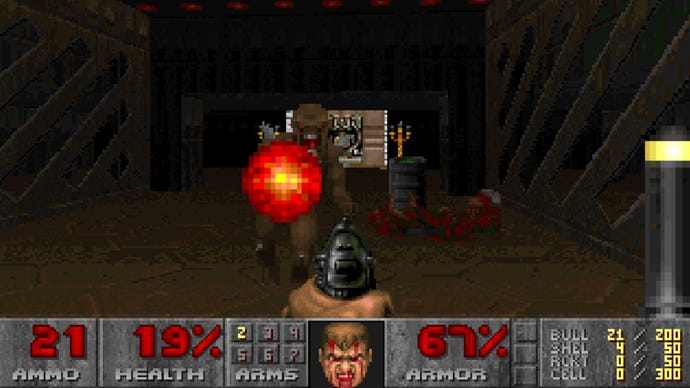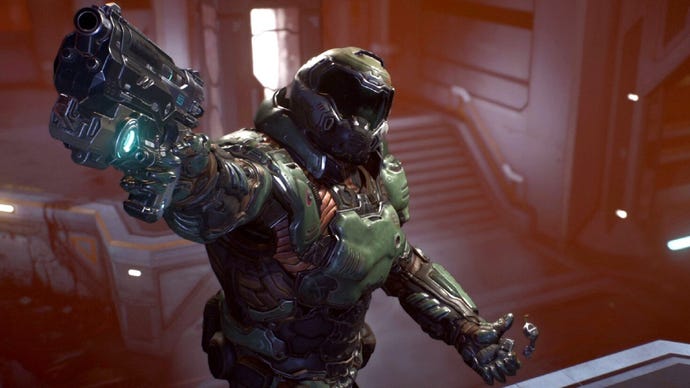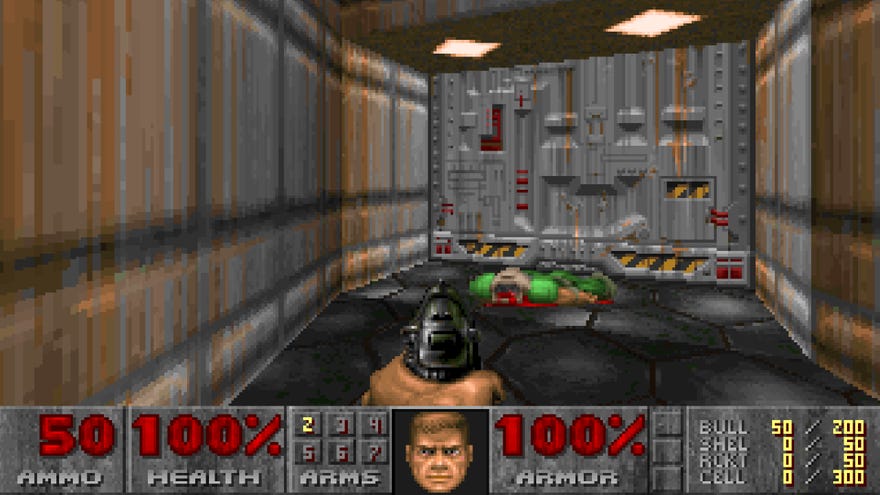Doom At 30: An ode to Doom, the first game to give me motion sickness
30 years of waiting for FOV options
Doom turns 30 this year, and that's a cause for celebration. There are many reasons to commemorate id Software's 1993 jaunt through the demon-infested corridors of Mars, from the fact that you can play it on every device known to man to its undying modding scene that even lets you pet Cacodemons. But I have a personal connection with Doom that's a bit special. It's the first game that made me so sick I wanted to puke.
I get visually-induced motion sickness very easily, and first-person shooters are excellent at triggering that spiraling feeling in my brain and gut. I'm not alone in this regard, as there are millions of kindred souls out there who also struggle with close-up cameras that trick us into thinking we're moving when we actually aren't. But camaraderie aside, I wasn't aware that my motion sickness could be triggered by video games until I encountered Doom.
I was maybe seven or eight years old at the time (probably way too young to be anywhere near Doom, but hey, it was the 90s) and my brother and I had got our paws on Knee-Deep In The Dead, the first shareware Doom episode. My brother took to it with supreme enthusiasm, because here was a truly radical game with lots of baddies you could blow to bits, and it was all so up close and personal. All of the gunplay, when combined with the kicking Adlib soundtrack, was balls-to-the-wall cool, and we were both amazed that Doomguy's face - centered as a lighthouse-esque anchor point in the middle of the HUD - became progessively bloodier the more damage he took.
At the time, I was a dedicated point and click adventure fan more at home with Sierra's King's Quest series than I was with anything so gutsy and gory. (Ironically, it's now public knowledge that Sierra came surprisingly close to purchasing id Software in 1992, which might've changed my gaming tastes.) But this didn't stop me from acknowledging that Doom was something truly special. The only problem was it made me so nauseous after ten minutes of playing that I had to retreat to my bed, burying my head in the sheets to stop the spinning. When my brother noticed that I wasn't doing so well, he asked me what had caused my traumatic state. I could only reply, "Doom makes me dizzy! So dizzy I want to barf!"

I eventually recovered after a few minutes, and made a solemn vow to never again engage with Doom. But this vow didn't quite take hold, since my brother kept playing the game, and my eyes would inevitably veer towards the computer whenever he had it on. I eventually developed a "watching Doom from the periphery of my vision" skillset, and I'd steal furtive glances here and there just in time to see my brother collect a key or shotgun an Imp. Then I'd quickly look away and refocus my eyes on the Archie comic book or whatever I was reading, safe in the knowledge that as long as I didn't observe too closely, I could get a fair idea of the action without having to deal with the crippling motion sickness that followed.
My brother blasted through Doom in a few weeks and went on to play most of its brethren from the era, including games that had technically released earlier, like the underrated Blake Stone: Agents Of Gold, the totally forgotten Ken's Labryinth, and Wolfenstein 3D, the father of Doom. There was also Heretic, which took Doom's dark aesthetic and transplanted it into a fantasy setting, which I really liked. But I could only watch these games cautiously out of the corner of my eye, rarely touching the controls myself or observing for too long - because every time I did, the nausea kicked in.
This was how it went for me and first-person games for most of my childhood, adolescence, and young adulthood. I either avoided them or only paid attention to them from a distance, acknowledging the genre as important to the development of electronic entertainment, but something that sadly wasn't for me. I'd occasionally become glum at the thought of all the great games I was missing, but whenever I tried to dip my toes back into the water - like the time when I briefly threw my lot in with a group of rebels who had brazenly installed Counter-Strike on school library computers - I felt just as sick as I had as a child.
As I grew older, however, the collective knowledge of the internet blessed me with many revelations. I became aware of how low framerates can trigger motion sickness, and I started hearing about something miraculous called FOV (field of view), or the range of a player's in-game vision. After seeing screenshots showcasing what various first-person shooters looked like at a higher field of view, I began to wonder if it wasn't so much the first-person perspective as it was the combination of a low FOV and frame rate in Doom that had made me so dizzy.
Despite this newfound wisdom, I still wasn't ready to take a second plunge to embrace the first-person shooter until Overwatch came out. Say what you will about Overwatch's foibles over the years, but the colourful characters combined with Tracer's giddy cry of "Cheers, luv! The Calvary's here!" were too tough to resist. Oh, and the FOV slider - which went up to 103, if I'm recalling correctly - certainly helped. Finally, I was playing a first-person shooter at lightning fast speed, with nary a thought of upchucking entering my mind.
Maybe it was fate that the 2016 reboot of Doom launched the same month as Overwatch, because once I'd had my fill of multiplayer Tracer shenanigans, I began looking for another first-person game with a hefty singleplayer mode that could test my new tolerance. There was the Doomguy, all shiny and reimagined for the 2010s, daring me to control him. It was like an invitation to go full-circle, and I couldn't say no.

Doom (2016) was a turning point in my gaming career, just as 1993's Doom had been so many years earlier. I was once again knee-deep in the dead, but now with decades of refinements by my side. The FOV slider went as high as it could, all options related to camera shake were turned off, and thanks to the Alienware 17 laptop I was rocking at the time, a low frame rate was never an issue. I started ripping and tearing with a vengeance, as if the spirit of my eight-year-old self was guffawing at all of those demons who had turned his brain into gobbledygook in the past. It was glorious, but even more important, it was accessible.
Since then, I've been undaunted by anything with a first-person perspective, as long as I can zoom the camera out to achieve that nice fisheye effect. (Heck, since joining RPS I've spent almost all of my time covering Modern Warfare 3, and even wrote a FOV guide for it. Wouldn't my younger self be amazed.) When a game doesn't have these features, if I really want to play it I'll hunt for a mod that lets me mess with the camera manually, which was what I had to do in 2020 when I was hit with the odd desire to play Call Of Cthulhu: Dark Corners Of The Earth. Thankfully, gaming has come a long way over the several years, and features like field of view are widely recognised as important quality-of-life extras in most games these days. For me, they're a little more than that - they're vital accessibility features that level the playing field, letting myself and so many others enjoy games that we normally wouldn't be able to (literally) stomach.
And so, on the event of Doom's 30th, I must acknowledge id Software's masterwork for ushering in a new style of first-person shooter that was bigger and brasher than anything that came before. If it weren't for Doom, we might not have had such an explosion in the FPS genre in the first place, and who knows, maybe the drive to make them more accessible with FOV sliders and the like wouldn't have happened either (or, at the very least, been slower to take effect). So many thanks, Doom; I tip my hat to you. Even if you did almost make me barf.










